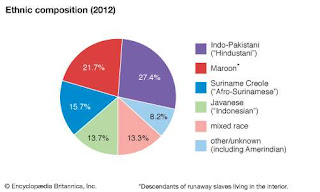interesting info on suriname (post 1)
Suriname, country located on the
northern coast of South America. Suriname is one of the smallest countries in
South America, yet its population is one of the most ethnically diverse in the
region. Its economy is dependent on its extensive supply of natural resources,
most notably bauxite, of which it is one of the top producers in the world. The
southern four-fifths of the country is almost entirely covered with pristine
tropical rainforest. Formerly known
as Dutch Guiana, Suriname was a plantation colony of the Netherlands that
gained its independence on November 25, 1975. From 1980 to 1987 the country was
governed by a succession of military regimes. A new civilian constitution was
approved in 1987. Another military coup took place in 1990, but the country
returned to civilian rule the following year. The capital, Paramaribo, lies 9 miles (15 km) from the Atlantic Ocean on the Suriname
River. Suriname’s major rivers flow northward
into the Atlantic. They include the Courantyne, which forms part of the
boundary with Guyana; the Coppename; the Suriname; and the Maroni, which forms
part of the border with French Guiana. Suriname’s most fertile soils occur in
the inundated lands reclaimed by diking and drainage (polders), which are
principally in the New Coastal Plain. South
Asians, descendants of contract laborers from India, are the largest ethnic
group in Suriname, making up more than one-fourth of the population. The
second major ethnic group, accounting for about one-fifth of the population, is
the Maroons (descendants of escaped slaves of African origin). Creoles, who in
Suriname are people of mainly African descent, constitute between one-tenth and one-fifth
of the population. The descendants of Javanese (people from the
island of Java in Indonesia) contract laborers and people of mixed ethnicity each make up almost one-seventh of the population.
Dutch
is the official language of Suriname, but the extent to which members of the
various ethnic groups are able to use the language differs. Most of the
population learns Dutch as a second language. Additional languages include Sranan and
other creole languages; English; Sarnami, which originated from Hindi and
Urdu; Javanese; and a number of Maroon and South American Indian
languages.


Comments
Post a Comment